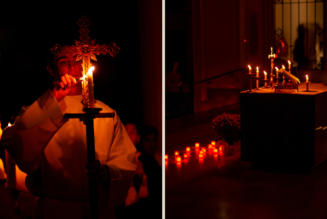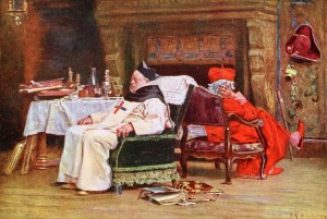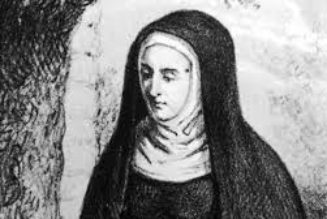
A new study has revealed that Gen Z is the first generation where more women are leaving religion than men. This shocking flip in the gender divide is another mile marker that women are on the wrong path.
I recently published the book The End of Woman: How Smashing the Patriarchy Has Destroyed Us to navigate and understand contemporary trends among women. I argued that feminism from the beginning has promoted an ideology that undermines faith and family. Several critiques have voiced disappointment that the book did not include a robust endorsement of Mary Wollstonecraft as a model for today’s women.
The most recent, by Nathan Schlueter, a Catholic father and professor at Hillsdale College, explains why I ought: “Wollstonecraft was pro-life, pro-marriage, and pro-motherhood and fatherhood.” She and other first-wave feminists, he explains, wanted “the flourishing of women, protection against bad men, and for good men to become chaste, loving husbands, caring fathers, and companions with their wives in the difficult duty of raising children.”
These elements are certainly important, but, unfortunately, there is much about the means through which Wollstonecraft thinks these can be achieved which should give us pause.
Wollstonecraft’s best-known work, A Vindication of the Rights of Woman (1792), was a political pamphlet published on the heels of the success of her first pamphlet, A Vindication of the Rights of Man (1790). The Vindication of the Rights of Man was leveled at Edmund Burke, an English/Irish member of Parliament and writer considered to be the founder of Anglo-American conservatism.
Burke was a well-known advocate of liberty movements around the world. He spoke out against English abuse in India, opposed slavery, generally favored the American Revolution, and, contrary to his own interests, defended the Irish against English oppression. He presciently warned of the extreme violence and dangers posed by the French Revolution and its hyper-rationalism and rejection of tradition.
One author, Yuval Levin, wrote of Burke, “What worried him, above all, was the combination of philosophical pretensions and applied savagery of the Revolution; mob rule making its case in metaphysical abstractions.” And he was exactly right, with roughly 20,000 innocent people killed, including numerous bishops, priests and religious.
Both of Wollstonecraft’s Vindications were written to appeal to the masses. In a castigating tone, she tears into Burke from the start:
“Mr. Burke’s Reflections on the French Revolution first engaged my attention as the transient topic of the day; and reading it more for amusement than information, my indignation was roused by the sophistical arguments, that every moment crossed me, in the questionable shape of natural feelings and common sense.”
Wollstonecraft’s second pamphlet, A Vindication of the Rights of Woman, is not as acerbic, but is still punctuated by savage scrutiny of Burke, the upper classes, the military, Christianity, philosophers and educators. It is not an easy or pleasant read and requires the reader to understand many period references and her unique and Enlightenment usages of terms, such as reason, virtue and conscience.
Wollstonecraft exhibited two distinct periods in her intellectual life. The first stage focused on the education of young women and trying to improve women’s lives through greater intellectual stimulus. The second period (from 1789 to her death in 1797) is marked by her involvement with a cadre of English Dissenters, Protestants who had separated themselves from the Church of England, stirred up by the French Revolution, including her publisher Joseph Johnson, Unitarian minister Richard Price, Joseph Priestly, Thomas Paine, and her future husband William Godwin.
Sympathetic commentator Virginia Sapiro said of Wollstonecraft that when she wrote her educational work, she was “a daughter of the Enlightenment,” but when she wrote the Vindications, she became “a sister of the French Revolution.” In both cases, neither is a model for young women today — especially conservative, Christian women trying to work out a solid theory and practice for living as an integrated woman in contemporary politics and culture.
Wollstonecraft’s goal in Vindication … of Woman was to build a future of freedom through Enlightenment ideals. Like Kant and other rationalists, she placed her hope in reason.
Through the faculty of reason, which the rationalists declared to be accessible to every man and woman, Wollstonecraft staked future prosperity for humanity. The Church, the military, and generally any male authority was viewed as the obstacle around which women had to navigate. If all of these could be eliminated and education improved, women could be free:
“I love man as my fellow; but his scepter, real, or usurped, extends not to me, unless the reason of an individual demands my homage; and even then the submission is to reason, and not to man. In fact, the conduct of an accountable being must be regulated by the operations of its own reason …”
At first glance, this seems reasonable and in alignment with Catholic thought, but amid the flowery prose, there are serious problems. Wollstonecraft’s concept of reason is the reason elevated by the Enlightenment (not of Aristotle or St. Thomas Aquinas) that was later worshipped in Paris by the revolutionaries focused on creating a scientifically rational world.
Burke and Wollstonecraft were at such odds with each other over many issues, but rationality played a central role (along with Price and Paine). Burke was explicitly critiquing the hollowed-out, hyper-rationalist Enlightenment approaches to reason.
Numerous others have added to his critique over the centuries, including C.S. Lewis and, more recently, Pope Benedict XVI’s famous Regensburg lecture. The problem with reductionist rationality is that it narrows and even cripples human understanding by eliminating authority, tradition and faith.
This was not simply an academic problem, as Burke predicted. The so-called rationalists that Wollstonecraft defended desecrated the Cathedral of Notre Dame; prostitutes were put on its sacred altars, and the church was renamed the Temple of Reason.
The philosophical ideas underpinning Wollstonecraft’s work represent the very things we are fighting against in the culture today: secularism, materialism, progressivism, relativism and even communism. Wollstonecraft’s work, driven by a desire to erase authority, including the Catholic faith, is not about building, but tearing down.
Contemporary feminists have used Wollstonecraft’s work to strengthen their argument that women have always been treated badly. This is also why Elizabeth Cady Stanton’s Declaration of Sentiments is so revered because of her statement that “[t]he history of mankind is a history of repeated injuries and usurpations on the part of man toward woman, having in direct object the establishment of an absolute tyranny over her.”
Both together made a strong case that feminism was a necessary ideology to remedy universal wrongs, despite significant evidence to the contrary, particularly in Catholic societies, where the Virgin Mary was honored, female saints were remembered, and women religious were prevalent.
Not coincidentally, Wollstonecraft’s popularity has surged since the 1970s, when her Vindication … of Woman was reprinted after centuries of neglect, right when the New Left was promoting the Marxist notion of women as victims and men as victimizers. The very seeds of the New Left were planted by Wollstonecraft’s cadre, including her husband Godwin, who influenced Marx, and her friend the radical Thomas Paine.
Independence
A common element in Wollstonecraft and most other feminist leaders is that their difficult experiences have led to the belief that isolation from a family is the better way forward. Wollstonecraft’s own life was punctuated by very difficult relationships; her father was abusive and vicious, her mother passive and indifferent. She had several failed romances, including one with an American in Paris who abandoned her and their child. She attempted suicide twice.
Wollstonecraft eventually found love and companionship with William Godwin after years of tumult. Shortly after their relationship started, Mary became pregnant. They decided to marry, despite Godwin’s public belief that monogamy is a kind of slavery. It is not hard to see where her acrimony to the status quo was derived. Tragically, she died 10 days after delivering their daughter, who grew up to be Mary Shelley, author of Frankenstein.
The feminist creed has promoted a kind of independence transformed into risk management — an effort to avoid the inevitable suffering that comes with loving others. Women are by nature vulnerable, but vulnerability isn’t something to evade; it is through that vulnerability, particularly in childbearing and rearing, that humanity continues. The onus should be upon creating a civilization in which vulnerability is considered and cared for and the needs of women met. When society does not reflect this, as in Wollstonecraft’s day and our own, there is something compelling about avoiding a broken heart and never losing a child or having to struggle to keep a marriage together; but avoiding possible heartbreak comes at a great cost — a life of love and purpose. The risk aversion that feminism provides is never going to protect women from difficult things. It is a natural thing to want to protect ourselves, but a kind of protection that shuts out necessary and authentic goods is not the right defense.
Feminism takes from women an essential thing that is meant to be said to husbands, to children: “l love you, and I will never leave you.” This is not only what creates the conditions for good things to happen and families to flourish, but it mimics God’s quiet whisper into the female heart. He says to us, “l love you, and I will never leave you.”
Feminist leaders like Wollstonecraft, despite her profession of a Christian faith, seemed not to have experienced this. This is what every woman must learn: Bad things will happen, but creating a protective skin under a guise of independence isn’t going to make us happy or bring necessary healing. We are made for something much better. We are made to love, to forgive, to serve, to sacrifice, to trust — within the order that God has created for us.
Mary as a Model
Later in his review of my book, professor Schlueter uses the example of spirited and intelligent women, presumably, to demonstrate what will happen in the lives of women who follow Wollstonecraft’s lead. “Gentlemen don’t feel threatened by strong, intelligent, talented, and spirited women. The Virgin Mary, Yes! But also Judith, Mary Magdalene, Joan of Arc, and Gianna Molla.” To this, I heartily agree. But gentlemen do feel threatened by bitter, condescending, angry women, which is what characterizes feminism, including Wollstonecraft. Most important, as Schlueter’s list makes plain, none of these women needed Wollstonecraft to inspire her life; all were inspired by a different spirit, the spirit of God. With women like this and millennia of female saints, like Teresa of Avila, Catherine of Siena, Hildegard of Bingen, the question must be asked: What is it exactly that Mary Wollstonecraft is adding anew to Catholic women? We need more than just someone who checks the boxes of “pro-life, pro-marriage, and pro-motherhood and fatherhood.” We need the example of women inspired by the spirit of God, by the Holy Spirit, not a spirit that is bitter, condescending and philosophically problematic. We don’t need a new wave of so-called conservative feminism built from the repackaged ideas of earlier radical leftism.
We are not 18th-century English women. We are 21st-century Catholic women who have wide political and economic rights and who increasingly dominate previously male-dominated professions, including education, medicine and law. We have also seen the devastating fruits in society wrought by feminism: Women are not happier, faith is evaporating, the nuclear family is disappearing, and vocations are waning. Hook-up culture, LGTBQ+, rampant divorce, STDs, abortion and contraception are our main concerns amid civilizational decline, the likes of which Wollstonecraft could scarcely imagine and for which her thought offers no remedy.
Mary Wollstonecraft is not the Mary upon whom we ought to be relying to reinvigorate our faith, families, churches and culture. That job has most certainly been reserved for another Mary — Mary, the Mother of God, and our mother, and the many saints and heroic women who have followed her.







